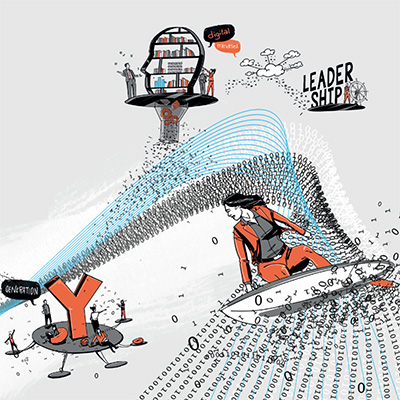
The Digital Wave
Understanding Thought Leadership in Organizations
Thought leadership is a crucial concept within the realm of organizational effectiveness, characterized by innovative thinking, subject matter expertise, and the ability to inspire and influence others. It goes beyond traditional leadership by incorporating forward-thinking ideas and a broader vision that challenges the status quo. Thought leaders are not just managers; they are visionaries who inspire change and drive organizations towards greater adaptability and resilience.
At its core, thought leadership involves a deep understanding of industry trends, analytical prowess, and the capacity to foresee future challenges and opportunities. Thought leaders leverage their expertise to foster an environment conducive to innovation, promoting a culture that values continuous learning and improvement. This proactive mindset helps in aligning the organization’s strategic goals with emerging market trends, thereby enhancing overall organizational effectiveness.
One of the prominent ways thought leaders influence organizations is through their ability to shape the strategic direction. They introduce new frameworks and methodologies that propel organizations towards growth and competitiveness. By constantly questioning existing processes and encouraging the adoption of cutting-edge practices, they ensure the organization remains agile and forward-focused.
Examples of well-known thought leaders illustrate the profound impact they can have. Leaders like Elon Musk transform industries by envisioning radical changes and fostering a culture of innovation within their organizations. Similarly, figures such as Sheryl Sandberg have championed new paradigms in leadership and organizational culture, emphasizing transparency, empathy, and diversity.
Characteristics that distinguish thought leaders from traditional leaders include their proactive approach to problem-solving and their relentless pursuit of knowledge. They are not merely administrators but harbingers of change, capable of inspiring their teams to exceed conventional boundaries. Their success often lies in their ability to foster a learning-oriented environment where team members are encouraged to experiment, learn from failures, and continuously seek improvement.
In conclusion, thought leadership is integral to driving organizational effectiveness. By promoting innovative thinking, influencing strategic direction, and fostering a culture of learning, thought leaders play a pivotal role in shaping the future of their organizations.
“`html
Implementing Thought Leadership to Boost Organizational Performance
Integrating thought leadership into an organization involves developing a culture that promotes innovation, open communication, and continuous learning. For organizations to enhance their effectiveness, it is essential to cultivate an environment where new ideas are valued and collaborative efforts are encouraged. This begins with leadership setting the example, fostering a mindset that embraces change and values the input of all team members.
Identifying and developing internal thought leaders is a crucial step in this process. Organizations should focus on nurturing talent through structured mentorship programs, offering platforms for employees to share their insights, and investing in continuous professional development. By creating opportunities for employees to grow and demonstrate their expertise, organizations can cultivate a robust internal network of thought leaders who drive innovation and improvement across all levels.
In addition to leveraging internal talent, organizations can benefit from collaborating with external thought leaders. Engaging with industry experts and thought leaders beyond the organization can provide new perspectives, stimulate fresh ideas, and encourage knowledge sharing. This collaboration can be facilitated through industry conferences, webinars, and collaborative projects, all contributing to a broader organizational knowledge base and fostering a culture of continuous learning.
Implementing thought leadership initiatives is not without challenges. Resistance to change is a common obstacle that organizations may face. To overcome this, it is critical to align thought leadership activities with organizational goals and to clearly communicate the benefits to all stakeholders. Leaders should be transparent about the objectives and expected outcomes, ensuring that the entire organization understands and supports the initiatives.
Successfully integrating thought leadership can have a tangible impact on performance metrics. For instance, companies that have embraced these initiatives report higher employee engagement, increased productivity, and improved market competitiveness. Real-world examples, such as the transformation of a leading tech company through a robust thought leadership program, highlight how these efforts can lead to significant enhancements in organizational performance.
“`



